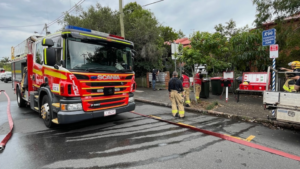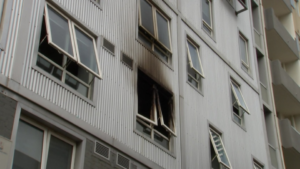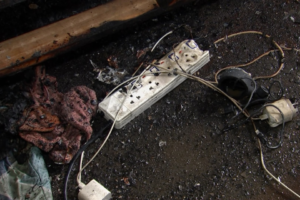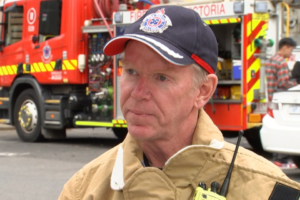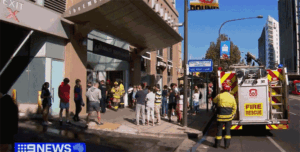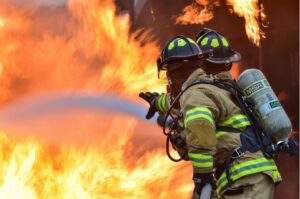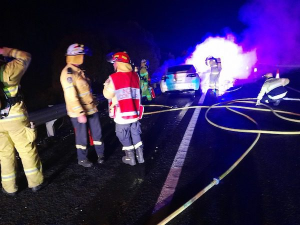Date Posted: 22 April 2024
Summary
- Lithium-ion batteries are being installed in computer data centres
- Existing fire protection standards not designed for Lithium-ion batteries
- Note NFPA Codes mentioned in this article are American Standards
There has been an increase recently in the number of fires that are being reported in the press in relation to Li-ion batteries. The issues related to these fires stem from either defective battery installations or insufficient or improper fire suppression being specified.
I recently acted as an expert witness in a case where the applicable guidance documents, at first sight, did not require the provision of fire suppression in battery rooms. The applicable guidance document was written not so long ago but did not consider the specific risks inherent to Li-ion batteries.
In another case, clean agent fire suppression was specified as coverage for battery rooms. The specification was again based on the applicable standards and guidance documents.
Unfortunately, a fire occurred, and the clean agent system did not extinguish or control the fire.
These apparent faults in the specification and guidance documents could have been avoided if there had been a fire engineering analysis, or by looking a bit further and consulting other standards and literature and delving a bit deeper into the subject. What is surprising, and at the same time concerning, is that a dedicated fire engineering team was involved in the design and construction of the project.
In this article, I illustrate the specific risks inherent to Li-ion batteries, the potential risk mitigations, and the guidance from codes and standards. I will conclude with my opinion on what the role of the fire engineer should be in dealing with projects where specific risks exist such as those inherent to Li-ion batteries.
Li-ion Batteries in Data Centres
Li-ion batteries are becoming increasingly popular in data centres due to their high energy density, longer lifespan, and lower maintenance costs compared to traditional batteries.
In data centres, Li-ion batteries are used as a backup power source for uninterruptible power supply (UPS) systems. They are preferred over other batteries because they can provide more power in less space. Li-ion batteries are also faster to charge and discharge than other battery types, which makes them ideal for use in data centres where power outages can cause significant damage.
Li-ion Battery Hazards
However, Li-ion batteries are still a relatively new technology, and there are still many unknowns regarding their performance and reliability.
With regard to data centre fire protection, the risk of thermal runaway, which can cause the battery to overheat and catch fire, is a concern. Therefore, it is important to ensure that Li-ion batteries are used in a safe and controlled environment.
Thermal runaway reaction
Chemical reactions are either endothermic or exothermic. In layman’s terms, endothermic reactions need energy to happen, exothermic reactions release energy. Many chemical reactions, including the chemical reaction that happens in the case of many Li-ion incidents, are exothermic.
The picture below shows the exothermic reaction process which accelerates when the released heat cannot be dissipated quickly enough.
Figure extracted from Wikipedia – Thermal runaway.
Thermal runaway is a process in which an exothermic reaction goes out of control, causing a further increase in temperature and, hence, a further rapid increase in the reaction rate.
In Li-ion batteries, thermal runaway is a phenomenon in which the lithium-ion cell enters an uncontrollable, self-heating state. This can occur when a lithium-ion battery is damaged, overcharged, or exposed to high temperatures. According to UL Research Institutes[1], during thermal runaway, the battery generates heat at a rate several times higher than the rate at which heat dissipates from the cell. The cell reaches thermal runaway when its temperature rises uncontrollably at a rate greater than 20°C per minute with maximum temperatures reaching greater than 300°C accompanied by gas and/or electrolyte venting, smoke or fire or a combination of all.
The risks associated with thermal runaways include the ejection of gas, shrapnel, and/or particulates, extremely high temperatures, smoke, and fire.
How to stop a thermal runaway reaction
Knowing how to stop a thermal runaway reaction is vital for data centre fire protection. To stop a reaction, it is important to remove the heat source and cool the reaction mixture as quickly as possible. In chemical processes, this is typically done by using a heat exchanger, or temperature control device, by adding a reaction inhibitor or quenching the reaction by cooling, or by directly dumping the reaction mixture into the quenching liquid itself.
Fire suppressions systems
In data centres, clean agent gaseous fire suppression systems are often used as they are generally suitable for electrically energised fires. The application of water from deluge or sprinkler systems is often discouraged because it allegedly is unsuitable to fight electrically energised fires. It can cause short-circuits increasing the risk of electrocution for persons in the room of electrically energised equipment. It is also claimed that water can cause more damage than the fire itself.
Fires are suppressed by removing or disrupting one of three elements needed to sustain a fire: heat, oxygen, or the fuel source.
Clean agent fire suppression systems may not be effective in stopping a thermal runaway reaction as a clean agent fire suppression system does not provide the required cooling. The clean agent fire suppression may reduce the oxygen concentration in the room, however, the thermal runaway is a chemical reaction that does not stop by simply removing or reducing the oxygen levels.
In other words, a clean agent fire suppression system may temporarily reduce or even extinguish the fire, it will not stop the runaway reaction with the result that a fire that is suppressed temporarily will re-ignite again.
Guidance documents
Initially, the absence of specific safety protocols tailored to Li-ion batteries led to incidents involving thermal runaway, fire outbreaks, and explosions. These incidents prompted a concerted effort by regulatory bodies, industry experts, and research organisations to establish comprehensive safety guidance and standards.
The National Fire Protection Association (NFPA), Underwriters Laboratories (UL), and Factory Mutual (FM) were among the pioneering organizations that took a proactive role in formulating guidelines to address Li-ion battery hazards. NFPA’s NFPA 855[2], UL’s UL 9540[3], and FM’s Property Loss Prevention data sheets 5-32[4] (FM DS 5-32) are exemplar standards developed to ensure the safe installation and use of energy storage systems, including Li-ion batteries.
NFPA 855 outlines requirements for the installation, design, and maintenance of energy storage systems, emphasizing fire safety measures. It covers aspects such as thermal runaway mitigation, proper ventilation, fire suppression systems, and emergency response planning, thereby significantly reducing fire risks associated with Li-ion batteries in various settings.
More specifically, NFPA 855 defines requirements regarding the compartmentation of battery rooms, and it states that the battery room should be separated from the data centre room where the maximum stored energy exceeds 600 kWatt Hour.
The standard states that sprinkler systems are highly recommended and formulate the design criteria to which the sprinkler system must comply in the case of Li-Ion battery rooms.
Note that NFPA 855, like most important NFPA standards, undergoes updates every 3 years.
Similar to NFPA 855, FM DS 5-32 outlines design requirements. It specifically states not to use clean agents or water mist systems. It also defines how server racks where Li-ion distributed power systems are used need to be constructed as indicated in the below figure extracted from FM DS 5-32.
Note the required metal barriers after every 3rd server rack as a measure to mitigate the impact of a possible thermal runaway.
UL 9540 focuses on evaluating the safety of energy storage systems by assessing their electrical, mechanical, and thermal stability. UL certification following rigorous testing procedures assures the safety and reliability of Li-ion battery systems.
Continuous advancements in technology and ongoing research have further contributed to the development of updated safety standards. Emerging innovations, such as smart battery management systems, and improved thermal management techniques, continue to shape the evolution of safety protocols for Li-ion batteries.
Researchers are also working on the battery materials themselves by replacing flammable liquid electrolytes with more stable, solid electrolyte materials such as non-flammable gels, inorganic glass, and solid polymers to create solid-state batteries. They are also developing cathodes that release less oxygen when they break down and separators that can withstand high temperatures without melting.
These technological innovations, when implemented, will reduce or perhaps eliminate certain fire risks such that revisions to the current standards will be required.
TWO MORE E-SCOOTER FIRES IN APARTMENTS
E-scooter fire leaves two people in critical condition after suffering extensive burns
Date Posted: 20 April 2024
Twelve Queensland Fire and Emergency Service crews attended the scene of a unit fire in inner-city Brisbane.
The cause of a Brisbane unit fire that left two people in an induced coma after suffering extensive burns has been revealed.
Fire investigators say an e-scooter which was left charging in the lounge room of the unit caused an explosion which started the fire.
Emergency services were called to Bowen Terrace in New Farm about 9am Saturday morning.
Twelve fire crews were battling the blaze which is now contained.
A Queensland Ambulance Service spokesperson said a man and a woman had suffered extensive burns and were placed in an induced coma.
They were then transported to Royal Brisbane and Women’s hospital, the spokesperson said.
Another man in his 50s was also taken to the hospital and treated for smoke inhalation.
Two other people, who were suffering from smoke inhalation, were assessed by paramedics at the scene but did not require hospitalisation.
A Queensland Fire and Emergency Service (QFES) spokesperson said early investigations suggested the intensity of the fire was due to clutter in the small unit and described the conditions as a ‘perfect storm’ for fire.
The spokesperson confirmed two visitors had been staying in the loungeroom of the unit and left the e-scooter on charge.
The owners of the unit managed to escape towards the back of the unit, the ABC understands the visitors also tried to evacuate themselves but were inhibited by furniture.
Police have declared the fire as non-suspicious.
Source E-scooter fire leaves two people in critical condition after suffering extensive burns – ABC News
Fire authorities warn of lithium-ion battery risks after two students narrowly escape Melbourne fire
Around 50 people were evacuated from the building early on Thursday morning.(ABC News)
- In short: Two students were awoken after a lithium-ion battery-powered mobile phone bank exploded, setting their bed alight.
- Fifty residents in the Carlton student accommodation building were forced to evacuate as firefighters quickly contained the fire.
- What’s next? Fire authorities have warned the frequency of lithium-ion battery fires is growing, and energy experts have urged consumers to check their products are up to Australian standards.
Victorian fire authorities say they’re responding to almost one lithium-ion battery fire every day, in the wake of a dramatic blaze which threatened dozens of people in Melbourne’s inner north.
About 50 residents were forced to evacuate a Carlton student accommodation building on Thursday morning, due to a fire sparked by an exploding lithium-ion battery.
Fire authorities said two university students were sleeping when a mobile phone power bank beside their bed exploded, quickly setting their bed alight.
The fire was contained to one bedroom, but fire authorities said it “caused a fair bit of damage”.
Fire services said the apartment was “gutted” by the fire.(ABC News).
“The room has been gutted by fire as a result of the explosion of that power bank, and they won’t be able to reoccupy that room anytime soon,” Fire Rescue Victoria’s Commander Paul Eckholdt said.
The two students have been assessed for smoke inhalation but were released by Ambulance Victoria.
Lithium-ion batteries a growing concern for fire services
Commander Eckholdt said lithium-ion batteries were a growing concern for fire services, which are responding to almost one fire per day caused by lithium-ion batteries.
“What we are finding is that a lot of people are charging devices while they’re asleep — phones, computers, scooters, that type of thing,” he said.
Commander Paul Eckholdt says lithium batteries are a growing concern for fire services everywhere.
Earlier this year, two people were killed in a house blaze authorities believe was caused by a lithium-ion battery in New South Wales.
Commander Eckholdt said the frequency of the fires highlighted the need for working smoke detectors.
“We want to warn the community that absolutely working smoke alarms save lives,” he said.
Safety tips for lithium-ion batteries:
- Only buy lithium-ion battery products from reputable sources and check for the Regulatory Compliance Mark
- Make sure all devices are compatible with the batteries you’re using to charge them
- Avoid over-charging your device. Once it’s reached 100 per cent charge, unplug it
- Always make sure you have thought about an escape route from your home if the battery starts a fire
“We recommend you have smoke detectors interconnected throughout your house and in your bedrooms.
“It’s really, really important for people that when they are charging phones, lithium-battery products, scooters, electric bikes, that they have a smoke detector operating … and to make sure they supervise that.”
Not all battery products up to Australian standards
Leanne Hughson, chief executive officer of Energy Safe Victoria, said it was important Australians bought lithium-ion battery products from reputable suppliers.
“Our very strong advice to consumers is to make sure you’re buying batteries from reputable suppliers; don’t buy them from the internet when you don’t know who the supplier is,” she said.
Safety authorities say Australians should check battery products for this Regulatory Compliance Mark (RCM). (Supplied: Electrical Equipment Safety System)
Other critical safety measures include ensuring devices are compatible with batteries, not “over-charging” devices and charging in a safe location.
“Be really careful about over-charging your device. Once it’s at 100 per cent, it’s charged, so you can take it off and unplug the charger,” Ms Hughson said.
“Also, make sure there is an escape route or that it’s outside in the garage and that you’re not blocked from getting out the door if a fire does occur.”
Source https://www.insurancejournal.com/magazines/mag-features/2024/04/15/769317.htm
Fire in Hotel Apartments Adelaide caused by guest charging e-scooter
Published date: 08/04/2024
Emergency services responded to fire alarms at the Adelaide North Terrace hotel just after 10.30am on Saturday 6 April.
Fortunately, all guests managed to be safely evacuated from the hotel and there were no reports of injuries.
The fire was contained to one room on the 12th floor; however, significant water damage was caused to rooms over several floors due to sprinkler activation.
Fire investigators attended and examined the scene.
The cause of the fire has been determined to be an electric scooter recharging. The e-scooter has been seized for forensic examination.
HOW TO AVOID A HOLIDAY DISASTER AND FIREPROOF YOUR CARAVAN
Published Date: 2/4/2024
More and more holidaymakers will be travelling with electric scooters. There is a risk of a fire in a caravan or cabin in a caravan park, with the added possibility of the fire spreading in the park.
On Sunday 31st March 2024, a caravan burst into flames in Perth bushland due to issues with a lithium-ion battery.
This fire is one of many incidents caused by lithium-ion batteries, with 110 fires being attributed to these batteries in the last year.
Assistant Commissioner Metropolitan Operations Jon Broomhall told Chrissy Morrissy on 6PR Afternoons, “There are a number of safety things people need to think about with lithium-ion batteries.”
“It’s really important people change them on a hard surface away from any flammable items…and to have a smoke alarm in and around any property where you’re sleeping, so in your house or in your caravan,” Assistant Commissioner Broomhall said.
“The best thing to do [if a lithium-ion battery fire erupts] is disconnect it from any power, get it into open air, and douse it with as much water as you possible can,” Assistant Commissioner Broomhall said.
Listen to the broadcast here.
Source: https://www.6pr.com.au/caravan-fire-caused-by-lithium-ion-battery-tips-for-safe-usage/
ELECTRIC VEHICLES, BIKES AND SCOOTERS UNDER FIRE SAFETY SPOTLIGHT
Published: 26th Mar 2024
Emergency services, auto groups, insurers and battery experts will weigh in on the safety of electric and hybrid vehicles at a parliamentary inquiry.
But the NSW inquiry sitting on Tuesday could spend much of its time discussing regulations for electric bikes and scooters rather than cars, as experts warn of inadequate safety measures and inferior imported products being sold to consumers.
The inquiry comes after a spate of devastating fires involving the two-wheeled devices, with Fire and Rescue NSW reporting blazes involving personal mobility vehicles almost tripled in 2023.
The NSW Joint Standing Committee’s Electric and Hybrid Vehicle Batteries Inquiry has drawn more than 30 submissions since it was called in October 2023.
Committee chair Greg Warren said the inquiry would probe whether “enhanced training, safety equipment and support” would be required to deal with the growing number of electrified vehicles on the state’s roads.
EV FireSafe chief executive Emma Sutcliffe, who is due to appear before the inquiry, said in her submission that Australia had experienced just six electric car fires and the vehicles currently represented a “very low risk”.
Light delivery electric vehicles presented a “moderate risk”, however, and vehicles such as e-scooters and e-bikes were classified as “high risk” by the agency.
Emergency workers were yet to receive “standardised training” in how to deal battery fires, said Ms Sutcliffe, and as a result were “increasingly unable to protect people and property” when lithium-ion batteries exploded.
The Insurance Council of Australia also called for greater regulation of battery-powered bikes and scooters as current laws were allowing the importation of “cheap, non-compliant products” that were putting households at risk.
“Stronger regulatory enforcement activity around the importation and sale of this type of product will help to reduce rising incidence of unsafe products,” the group’s submission said.
Calls for new laws around the technology were also mirrored in submissions from Bicycle NSW, which called for rules around modified vehicles and non-compatible chargers. Bicycle Industries Australia said Australians needed guidelines about their safe use.
New rules should include details about how to safely store and charge e-bikes and e-scooters, the group said, as well as outlining what modifications were legally allowed and recording “the number and cause of all lithium-ion battery fires”.
In its submission, Lithium Batteries Australia and LifeTech Energy said companies proved to be importing “inferior, potentially hazardous lithium batteries” and making false claims about them should be legally prosecuted.
Fire and Rescue NSW reported 61 e-bike and e-scooter fires across the state in 2023, up from just 22 the year before.
Source: Electric vehicles, bikes and scooters under fire safety spotlight (thedriven.io)
NEED FOR NATIONAL STANDARDS
Published: 16th Mar 2024
NSW Energy Minister Penny Sharpe said this week that the state government was in talks with the federal government to strengthen laws surrounding lithium-ion batteries.
“There’s very reputable battery suppliers but people are getting cheaper ones as e-bikes proliferate,” she said.
But while it’s understood what can create these fires, one issue is a lack of consistent guidelines and regulations.
Currently, electrical safety is regulated by each state and territory.
In October, the ACCC published a report which noted that the “current regulatory framework does not squarely address the safety risks” of lithium-ion batteries.
ACCC deputy chair Catriona Lowe told the ABC that, while incidents were low compared to the quantity of lithium-ion batteries in Australia, those incidents can be “very serious”.
“This is why it is incredibly important that the regulatory frameworks adequately respond to what are going to become more and more common products, particularly as we move through our transition to net zero,” she said.
According to the report, there is no national quality standard or lithium-battery disposal guidelines, potentially contributing to confusion and variation in product safety.
There is also no national database to track incidents.
The same report highlights that Australian Consumer Law does not “contain the full suite of tools needed to effectively regulate specialist products, such as electrical products”.
“We are supportive of retaining the state and territory expertise, but what we would like to see is a nationally consistent framework,” Ms Lowe said.
NSW Minister for Better Regulation and Fair Trading Anoulack Chanthivong said the state was working with state and federal governments
“Fair Trading is working with emergency services to inspect products on the market today but consumers buying cheap products online should exercise caution,” he said.
Since March 2023, NSW Fair Trading has conducted inspections of 195 retailers selling electrical articles, including 39 models of e-bikes and e-scooters.
“While securing a national approach will take time, NSW is moving ahead with proactive compliance programs and we’re looking at ways to increase education about the safe use of these products,” Mr Chanthivong added.
Source Low-quality products could be behind increased number of lithium-ion battery fires in NSW – ABC News
E-BIKE WITH MODIFIED LITHIUM-ION BATTERY BEHIND UNIT FIRE THAT INJURED MAN
Published: 14th March 2024
A charging e-bike with a modified battery burst into flames at a unit in Sydney this morning, injuring a man and sparking serious safety concerns.
At least 40 residents were forced to evacuate a 10-storey building on French Avenue in Bankstown about 6.30am after an e-bike caught fire in a unit.
The building’s sprinkler system helped contain the flames coming from the third floor as firefighters arrived to extinguish the blaze and clear the smoke from the building.
Fire and Rescue NSW said one of the four unit occupants – a 30-year-old man – had attempted to move the e-bike and suffered a burn to his hand.
He was taken to Bankstown Hospital for further medical treatment. No other injuries were reported.
Since the blaze, firefighters have determined the e-bike was plugged in and charging when it caught on fire.
APPEAL FOR EXTRA CAUTION AROUND BATTERY USE AFTER APPARENT FIRST LITHIUM-ION FIRE DEATHS IN NSW – TERALBA
Published: 05th Mar 2024 02:28pm
Fire and Rescue NSW (FRNSW) is urging the public to be extra cautious after what appear to be the state’s first recorded deaths in a Lithium-Ion battery-related fire last week.
About 4.10am on Thursday 29 February, four people were inside a townhouse at Teralba at Lake Macquarie when a fire broke out.
FRNSW investigators believe a battery was compromised and immediately went into ‘Thermal Runaway,’ a process where a Lithium-Ion cell overheats and gives off toxic gases before exploding in flames.
Two of the occupants escaped the intense flames but two others inside the townhouse were killed, their bodies recovered from the unstable ruins on Friday and Saturday.
NSW Police are working to formally identify the victims and prepare a report for the NSW Coroner, who will formally decide the cause of the deaths.
The tragedies mark what FRNSW regards as the first deaths in NSW due to a Lithium-Ion battery-related fire.
According to the latest FRNSW statistics, there have been 45 Lithium-Ion battery-related fires in NSW so far this year, or five incidents a week.
There were 269 such fires in this state last year at the same weekly rate.
FRNSW is reinforcing its public warnings about the dangers of such batteries when comprised, damaged or allowed to overheat.
“This appears to be what we have been fearing for a while now, a person or persons dying due to a Lithium-Ion battery-related fire in this state,” FRNSW Commissioner, Jeremy Fewtrell, said.
“We continue to warn the community about the potential for these batteries to explode in flames,” Commissioner Fewtrell said.
“Use extra caution when using Lithium-Ion batteries…when they go into ‘thermal runaway,’ the danger is immediate.
“These fires are extremely intense and volatile, even our firefighters find putting them out challenging because they burn so hot.
“It’s vital the public follows our safety advice around these batteries.”
- Never sleep or leave home with your Lithium-battery-powered devices charging
- Don’t leave them constantly on charge
- If Lithium batteries are damaged or compromised, dispose of them properly
- Don’t throw them out in the rubbish, they can start garbage truck or rubbish tip fires when compacted
- Contact your local, approved recycling centre for disposal advice
- Don’t leave devices charging on beds, sofas or around highly flammable materials
- Try to charge devices outside if possible
- Always buy reputable Lithium-battery brands and never ‘mix and match’ components
- Beware of cheap, substandard Lithium battery-powered devices
- Avoid dropping, crushing or piercing battery cells
- Store batteries and devices in a cool, dry area, away from combustible materials
- Install active smoke alarms in your home/garage
- Ensure you have a home evacuation plan in the event of fire
- Don’t store or charge Lithium-Ion-powered devices near exit points in your home
For further information, visit the FRNSW website: https://www.fire.nsw.gov.au/page.php?id=9392 [external link]
THE FIRST AUSTRALIAN DEATH DIRECTLY LINKED TO A LEV LITHIUM-ION BATTERY HAS OCCURRED IN A CARAVAN.
Published: 2nd Mar 2024
An e-scooter battery left to charge overnight ignited & exploded. One of the occupants was killed. More and more holidaymakers will be travelling with electric scooters. There is a risk of a fire in a caravan or cabin with the charging and with the added possibility of the fire spreading in the park.
Woman seriously burned in e-scooter fire
A woman in her 20s was hospitalised in a serious condition after an electric scooter “unexpectedly combusted” and engulfed her car in flames.
Emergency services were called to Town Court, Boronia Heights, to reports of a car on fire close to a house.
The car was no longer on fire when crews arrived, but they found a woman inside.
Police say an electric scooter, put in the car’s boot by another person, suddenly combusted.
An ambulance service spokesperson said the woman suffered “significant burns to her chest, arms and legs, and was taken to hospital.
Source: Woman seriously burned in escooter fire – MyCity Logan
FIRE & RESCUE NSW BATTLES E-BIKE FACTORY FIRE IN CROYDEN, NSW
Published: 5th Jan 2024
Fire and Rescue NSW (FRNSW) is investigating the cause of a fire which destroyed an e-bike factory at Croydon, in Sydney’s inner west, this morning.
More than 60 firefighters and 15 fire trucks were deployed to Elizabeth Street, where the blaze broke out in the small building behind a row of shops just before 5 am.
FRNSW crews battled for more than two hours to contain the fire, having to attack it from outside the building due to concerns that parts of the structure might collapse.
Firefighters remain at the scene, where they continue to douse hotspots. Crews are assisting them in aerial fire trucks.
No injuries have been reported.
Once the building is made safe, experts from FRNSW’s Fire Investigation and Research Unit (FIRU) will examine where and how the fire started.
Published: 3rd Dec 2023
Three food delivery riders were rushed to hospital after an e-bike battery exploded in their apartment building in Sydney’s Inner West.
Firefighters were called to Annandale around midday as more than 100 residents were forced to evacuate the unit complex on Booth Street.
One man was seen being taken out on a stretcher.
He and his two roommates had finished a shift around 3 am and had left their bikes downstairs as the batteries charged.
Resident Michael Waples said he heard “a loud thud”.
“At first, I thought someone was moving furniture, then I heard a scream and commotion,” he said. Other neighbours found an injured international student in the hallway and helped him downstairs.
Paramedics treated him before being taken to Royal North Shore Hospital in a serious condition with burns to 40 per cent of his body.
His roommates were sent to Concord Hospital with minor burns.
Fireys managed to contain the blaze before it spread to other units in the complex.
Inspector Michael Woodward from Fire and Rescue NSW said there was a lot of damage to the unit.
“There wasn’t much in there; it’s a small one-bedroom unit, and it’s concrete walls and floors,” he said.
The incident is almost identical to an October explosion in a King’s Cross hostel.
To learn more about which contract works insurance is right for you, Contact Lewis Insurance Services on 07 3217 9015 or send us an email by clicking here.
This article was published by our AFSL Licensee, Insurance Advisernet Australia P/L, www.insuranceadviser.net
Disclaimer:
This information and any accompanying material does not consider your personal circumstances as it is of a general nature only. You should not act on the information provided without first obtaining professional financial advice specific to your circumstances and considering the Product Disclosure Statement.



